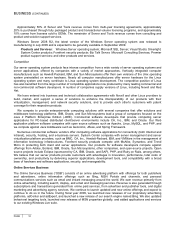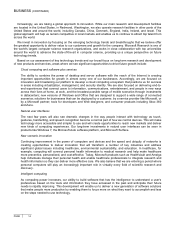Microsoft 2009 Annual Report Download - page 20
Download and view the complete annual report
Please find page 20 of the 2009 Microsoft annual report below. You can navigate through the pages in the report by either clicking on the pages listed below, or by using the keyword search tool below to find specific information within the annual report.
PAGE 20
MANAGEMENT’S DISCUSSION AND ANALYSIS OF
FINANCIAL CONDITION AND RESULTS OF OPERATIONS (CONTINUED)
Client offerings consist of premium and standard edition Windows operating systems. Premium editions are those
that include additional functionality and are sold at a price above our standard editions. Premium editions include
Windows Vista Business, Windows Vista Home Premium, Windows Vista Ultimate, Windows Vista Enterprise,
Windows XP Professional, Windows XP Media Center, and Windows XP Tablet PC. Standard editions include
Windows Vista Home Basic and Windows XP Home. Client revenue growth is directly impacted by growth of PC
purchases from original equipment manufacturers (“OEMs”) that pre-install versions of Windows operating systems
because the OEM channel accounts for over 80% of total Client revenue. The differences between unit growth rates
and revenue growth rates from year to year are affected primarily by changes in the mix of OEM Windows premium
edition operating systems licensed as a percentage of total OEM Windows operating systems licensed (“OEM
premium mix”). Additional differences in growth rates result from the impact from lower cost netbook PCs, which are
sold with a lower cost version of Windows, changes in geographic mix, and changes in the channel mix of products
sold by large, multi-national OEMs versus those sold by local and regional system builders.
Fiscal year 2009 compared with fiscal year 2008
Client revenue decreased primarily as a result of PC market weakness, especially PCs sold to businesses. OEM
revenue decreased $2.3 billion or 16% while OEM license units declined 2%. The decline in OEM revenue reflects a
10 percentage point decline in the OEM premium mix to 64%. Based on our estimates, total worldwide PC
shipments from all sources experienced a decline of approximately 1% to growth of approximately 2%, driven by
changes in demand in emerging and developed markets.
Client operating income decreased primarily reflecting decreased revenue and increased sales and marketing
expenses. Sales and marketing expenses increased $122 million or 7%, primarily reflecting increased advertising
and marketing.
Fiscal year 2008 compared with fiscal year 2007
Client revenue increased reflecting growth in licensing of Windows Vista. By the end of fiscal year 2008, more than
180 million Windows Vista licenses had been sold (approximately 130 million were sold during fiscal year 2008) and
millions of enterprise seats had been deployed. OEM revenue increased $1.8 billion or 14%, driven by 16% growth
in OEM license units. Revenue from commercial and retail licensing of Windows operating systems increased $202
million or 9%, primarily from Enterprise Agreements and anti-piracy efforts in emerging markets. During fiscal year
2008, the OEM premium mix increased seven percentage points to 74%, reflecting strong demand for Windows
Vista Home Premium. We estimate total worldwide PC shipments from all sources grew approximately 12% to 14%,
driven by demand in both emerging and mature markets.
Client operating income increased reflecting increased revenue, partially offset by increased sales and marketing
expenses and cost of revenue. Sales and marketing expenses increased $106 million or 7%, primarily reflecting
increased expenses associated with our corporate sales force. Cost of revenue increased $116 million or 14%,
primarily driven by Windows Vista product costs.
Other
The segment information discussed above is presented the way we internally managed and monitored performance
at the business group level in fiscal years 2009, 2008, and 2007. Effective July 1, 2009, we reorganized the
Windows Live operations from Online Services Business to Client to better align our strategies and focus in those
areas.
Server and Tools
(In millions, except percentages) 2009 2008 2007
Percentage
Change 2009
Versus 2008
Percentage
Change 2008
Versus 2007
Revenue $14,126 $13,102 $11,104 8% 18%
Operating income $5,327 $4,539 $3,571 17% 27%
























